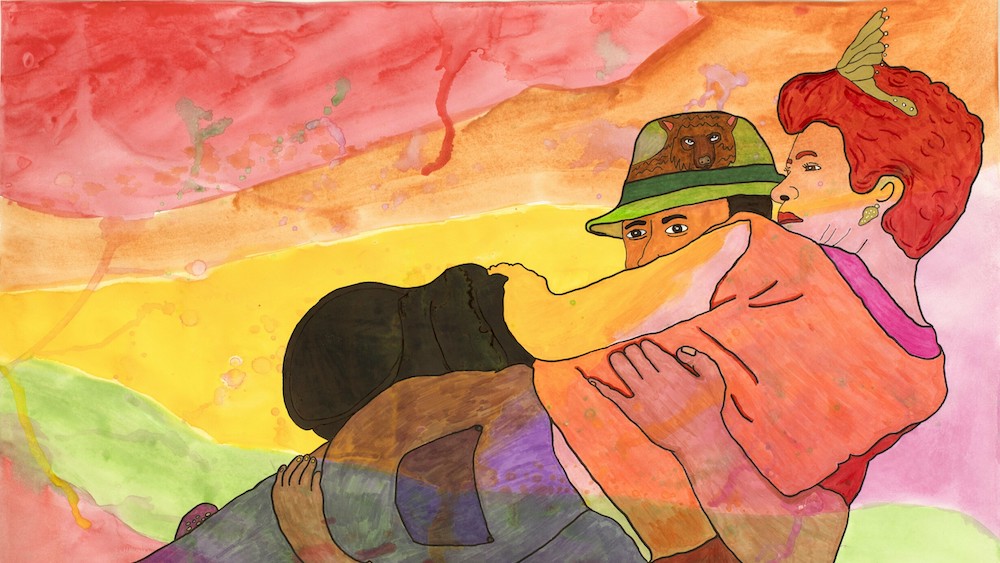Karla Diaz has been drawing since she was a child. The title of her current exhibition, “Wait ’til Your Mother Gets Home,” is something her aunt would say to her when she would draw on the walls of the family home. Consisting of 37 paintings and works on paper that, when seen together, become a personal narrative about the many facets of Mexican American identity, Diaz combines figuration and abstraction to explore and revisit her memories of growing up in Los Angeles. In these compelling works—many of which have the feel of posters from the 1960s—Diaz paints flatly rendered portraits and figures into abstract landscapes and cityscapes. The pieces reference Mexican, as well as Mexican American, traditions, and depict intimate moments with family and friends. The watercolor and ink-on-paper pieces oscillate between vivid and muted tones, giving them a soft, dream-like quality.
On the building’s exterior walls are five colorful, large-scale banners, each a self-portrait. One depicts Diaz as Frida Kahlo surrounded by a halo of red roses, while in another Diaz wears a bright blue eye patch. In Self Portrait with Raised Fist, Diaz holds a portrait of a male revolutionary in front of her face—his eyes obscured by dark sunglasses and his fist raised.
Moving from outside to inside, the works become smaller yet have a similar impact. Installed in a line along the gallery walls, the images begin to tell a story that weaves through Diaz’s life and relationships to familiar locations, be it the 99 Cent store, a swap meet, a park or subway interior, or significant moments like when family members crossed the border. In one of the smaller spaces, Diaz presents an installation that pays tribute to the civil rights activist Rubén Salazar, who was murdered on August 29, 1970, the day of the National Chicano Moratorium protest against the Vietnam War. Diaz not only paints a watercolor of the Silver Dollar bar, the location of his murder in The Silver Dollar (2021), but she also includes a separate painting of his bloodied body in Rubén Salazar (2023).
The backgrounds of Diaz’s works are a patchwork of splotches or loose gradients of bright color — pinks, oranges, greens, and yellows — that serve as a quirky and illustrative ground for her portraits and scenes. The figurative and narrative elements often merge with the background shapes and palette to create a layered effect that is more formal than content driven. Diaz’s drawn lines emerge from these color fields to depict people and places with admiration, wit and intensity. For example, in Dona Juana (2023), Diaz paints a woman in front of a stall holding a shoe in one hand and a cell phone with a portrait of a child as the background in the other. Her bright pink shirt is decorated with back-to-back exotic women with piled black hair, long eyelashes, and extended tongues. Dona Juana stares at the viewer and smiles.
No Te Metas Con Mi Cucu (Don’t mess with my ass) (2022) is an image of protest. Assembled are women holding pro-choice signs in front of a courthouse juxtaposed with a colorful rendition of an older man, who resembles Huey Newton, wearing a suit and pink tie and seated in a chair. While Diaz allows the forms and figures to overlap, the focus of the image remains intact. Although That Fire (2021) is acrylic on canvas rather than watercolor on paper, the intensity of the moment is deftly portrayed as Diaz tenderly captures the agony and dismay on the woman’s face while flames engulf the building behind her.
Diaz’s seductive images tell personal and universal stories. They are humble without being didactic, colorful, and to the point. The pieces are about domesticity and urban life while exploring how the two are intertwined. As a Mexican American, Diaz draws from her heritage and the world surrounding her. Her pieces fuse fact and fiction, dreams, and reality to create narratives about her experiences growing up and living in Los Angeles.


